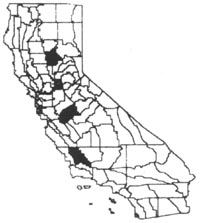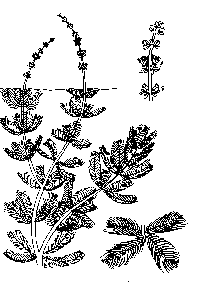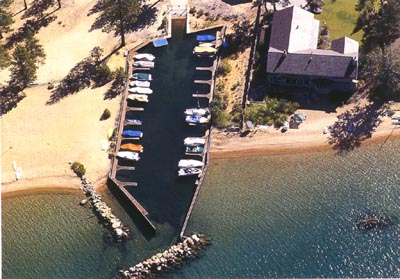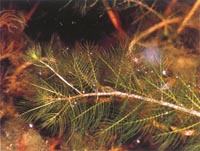|
Myriophyllum spicatum
|
|
|
|
Scientific name
|
Myriophyllum spicatum
|
|
Additional name information:
|
L.
|
|
Common name
|
Eurasian watermilfoil, spike watermilfoil
|
|
Synonymous scientific names
|
Myriophyllum exalbescens
|
|
Closely related California natives
|
3
|
|
Closely related California non-natives:
|
1
|
|
Listed
|
CalEPPC List A-1,CDFA nl
|
|
By:
|
Carla Bossard
|
|
Distribution
|
|
|
HOW DO I RECOGNIZE IT?
Distinctive features:
|
Eurasian watermilfoil (Myriophyllum
spicatum) is an aquatic plant with branching stems near the water surface,
creating dense floating mats. The feather-like leaves grow in whorls of four
around the stem, with each leaf divided into nine to twenty-one paired leaflets.
This wa-termilfoil is distinguished from the dioecious parrotÛªs feather (M.
aquaticum) by the fact that it is monoecious, does not have flattened midribs,
has only submersed foliage, and has longer stems at maturity (Hoffman and Kearns
1997).
åÊ
|
|
Description:
|
| Haloragaceae. Perennial, submersed aquatic plant. Stems: branching and leafy, 19.5-28 in (50-70 cm) long, generally >6.5 ft(>2 m) long, reddish or olive-green when dry. Stems thicken below inflorescence and double in width further down, often curving to lie parallel with the water surface. Stem fragments root freely. Leaves: submersed, feather-like leaves in whorls of 4; each leaf 0.6-1.6 in (1.5-4 cm) long, most often with 14-24 pairs of filiform divisions. |
|
Inflorescence: terminal spike, 4-20 cm long
and emergent, often pink. Spike erect at anthesis, parallel to water surface at
fruit set. Flowers: lower flowers pistillate, upper flowers staminate; flowers
verticillate in 4s, whorls 2-ranked, adjacent whorls rotated 45 degrees,
occasional hermaphrodite flowers in transition zone. Lower 2-4 whorls of floral
bracts usually pictinate and often longer than flowers; upper bracts entire,
broader than long and shorter than flowers. Female flowers lack perianth;
gynoecium 4-lobed with pink, tufted, recurved stigmas. Male flowers with pink,
cauduceous petals; 8 stamens. Fruit: subglobose schizocarp, 0.08-0.13 in (2-3mm)
long, 4-sulcate with two rather wrinkled ridges adjacent to lines of dehiscence
(from Aiken et al. 1979, Hickman 1993).
åÊ
|
|
WHERE WOULD I FIND IT?
|
Eurasian watermilfoil can be found in
freshwater lakes, ponds, and canals with slow-moving waters in northern and
central California, particularly in the San Francisco Bay and San Joaquin Valley
regions (Anderson 1990) and Lake Tahoe (Goldman, pers. comm.). It is found
throughout much of the United States from New England to Florida and westward to
California and Washington. Typically, it is rooted at water depths of three to
ten feet (1-5 m), but can spread to waters to thirty-three feet (10 m)
deep.
This watermilfoil can grow on sandy, silty, or rocky substrates
but grows best in fertile, fine-textured, inorganic sediments. It is an
opportunistic species that prefers disturbed substrates with much nutrient
runoff. High temperatures promote multiple periods of flowering and
fragmentation (Hoffman and Kearns 1997).
åÊ
|
|
WHERE DID IT COME FROM AND HOW IS IT SPREAD?
|
Eurasian watermilfoil is native to
Greenland, North Africa, Europe, and Asia. It was introduced from Europe to the
eastern United States in shipsÛª ballast before 1940 and had spread to California
by the 1960s (Couch and Nelson 1985, Aiken et al. 1979).
Eurasian watermilfoil produces some long-viable, often dormant
seed, but its spread results primarily from vegetative reproduction. The stems
are brittle and fragment easily. These fragments can settle in sediments,
producing new plants. Fragments are spread by boats or trailers, in bait
buckets, or by floating downstream. They can also be spread by waterfowl and
other wildlife (Aiken et al. 1979). Dumping surplus plants from aquatic gardens
or aquariums into waterways is another means of spread for this species (Hoffman
and Kearns 1997).
åÊ
|
|
WHAT PROBLEMS DOES IT CAUSE?
|
Eurasian watermilfoil grows and spreads
rapidly, creating dense mats on the water surface. These monotypic mats
outcompete native aquatic plants, reducing species diversity. Loss of
nutrient-rich native plants reduces food sources for waterfowl, impacts fish
spawning grounds, and disrupts predator-prey relationships by fencing out larger
fish (Hoffman and Kearns 1997). Infestations can alter aquatic ecosystems by
shading out algae in the water column that serve as the basis of the aquatic
food web. The mats inhibit recreational use of waterways for boating, fishing,
and swimming and cause flooding out of the waterway. Mats also can block
irrigation pumps and water intakes and provide optimal habitat for mosquitoes
(Aiken 1979, Parsons 1992). Millions of dollars annually are spent in the United
States and Canada on efforts to control Eurasian watermilfoil.
åÊ
|
|
HOW DOES IT GROW AND REPRODUCE?
|
Colonization of new sites is usually by fragments. Once
established in an aquatic habitat, Eurasian watermilfoil grows rapidly in spring
(March-April). Stolons, lower stems, root crowns, and roots persist over the
winter in California. In waters where temperatures do not drop below 50 degrees
F (10 degrees C) there is little seasonal die-back (Aiken et al. 1979). Root
crowns store starch that fuels early takeover of the water column (Grace and
Wetzal 1978). During the growing season this plant undergoes auto-fragmentation,
with fragments often developing roots before separation from the parent plant.
Sloughing of plant parts is common after flowering.
Flowering usually occurs in spring, but some plants flower in fall as well
(Pullman 1993). Flowers generally are wind-pollinated. Spikes lie parallel to
the water as fruits mature. Fruits float for some hours, allowing for some water
dispersal. Fruits do not release the seeds. Seeds exhibit prolonged dormancy,
and seedlings, although viable, are rare in nature (Cobble and Vance 1987; Aiken
et al. 1979).
|
Vegetative reproduction is far more
important in this species, with fragments being released throughout the
growing season (Madsen et al. 1988). Small axillary buds detach from the
root crown in late winter and may establish new plants during the growing
season (Aiken et al. 1979).
|
(click on photos to view larger image)
|
|
|
HOW CAN I GET RID OF IT?
|
Like other milfoils, Eurasian watermilfoil
is difficult to remove from an aquatic system once established, so monitoring
and prevention are the most important methods of control. Efforts to make the
public aware of the need to remove weed fragments at boat landings and a
watershed management program that keeps nutrients from unnaturally enriching
aquatic systems, which stimulates this species, are critical to its control
(Hoffman and Kearns 1997).
åÊ
|
|
Physical control:
|
Mechanical methods: Eurasian watermilfoil
can be removed by mechanical harvesters. However, native vegetation tends to be
removed by this method simultaneously, eliminating beneficial competitors. Also,
fragments are usually created, which contributes to dispersal. Harvesters should
be used only where colonies are widespread (Hoffman and Kearns 1997, Pullman
1993). Hand pulling, while time-consuming, can be used to control colonies
smaller than one acre (0.6 hectare). All fragments, including roots, must be
carefully removed. Where possible, anchored bottom screens can be used to
prevent new sproutings, but these must be cleaned of sediments once a year
(Hoffman and Kearns 1997).
Raising or lowering water levels can inhibit this species.
Raising the water level can deprive plants of access to light. This technique
can be augmented with light-limiting dyes or shade barriers. Lowering water
level can dehydrate plants or, in winter, freeze them to death (Bowen
1995).
åÊ
|
|
Biological control:
|
There are no USDA approved biocontrol
agents for Eurasian watermilfoil. A North American weevil, Eurhychiopsis
lecontei, feeds on Eurasian watermilfoil in the midwestern United States. It has
been shown to cause extensive damage in some populations, with a 50 percent
reduction in biomass and no significant effect on biomass of ten native plant
species (Sheldon and Creed 1995). The weevilÛªs effectiveness for controlling
watermilfoil on a large scale is under investigation in twelve Wisconsin lakes
(Hoffman and Kearns 1997).
The fungus Mycoleptodiscus terrestris is also being researched
as a potential biocontrol agent in Michigan and Massachusetts (Hoffman and
Kearns 1997). Grass carp (Ctenopharyngodon idella) used as a biocontrol on other
invasive aquatic species find watermilfoil unappealing.
åÊ
|
|
Chemical control:
|
Herbicide use is more highly regulated in
aquatic systems than in terrestrial systems and, because of dilution effects,
more difficult to use. The most recent version of herbicide labels will give
recommended rates and information about whether the compound is registered for
use in a specific situation. Two herbicides effective on Eurasian watermilfoil
are not legal for use in aquatic systems in California (diquat and 2,4,D
butoxyethenol ester, 20 percent attaclay). Since these herbicides are
non-selective, the potential disruption to and contamination of aquatic
ecosystems is deemed more problematic than the damage caused by watermilfoil
infestation.
Under some conditions, the herbicide fluridone has been approved
for lake or pond treatments in California, in low concentrations (10-13 ppb),
applied early in the season when water temperatures are low and most native
vegetation is not actively growing. Fluridone inhibits photosynthesis and
synthesis of important protein compounds in plants susceptible to it, as is
watermilfoil. The degree of impact is related to the concentration and the
amount of time the plant is in contact with the herbicide (Anderson 1981).
Fluridone is taken up by roots and shoots, but appears to be translocated only
from root to shoot (Marquis et al. 1981).
Glyphosate and triclopyr were found to be ineffective in control
of Eurasian watermilfoil in studies in Washington (Thurston County
1995).
åÊ
|




